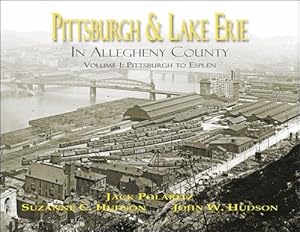jack polaritz suzanne hudson john (1 risultati)
Tipo di articolo
- Tutti gli articoli
- Libri (1)
- Riviste e Giornali
- Fumetti
- Spartiti
- Arte, Stampe e Poster
- Fotografie
- Mappe
-
Manoscritti e
Collezionismo cartaceo
Condizioni
- Tutte
- Nuovi
- Antichi o usati
Legatura
- Tutte
- Rilegato
- Brossura
Ulteriori caratteristiche
- Prima edizione
- Copia autografata
- Sovraccoperta
- Con foto
- No print on demand
Paese del venditore
Valutazione venditore
-
Pittsburgh & Lake Erie in Allegheny County Volume I: Pittsburgh to Esplen
Editore: Depot Square Publishing, 2021
ISBN 10: 0965136493ISBN 13: 9780965136495
Da: Arizona Hobbies LLC, Tucson, AZ, U.S.A.
Libro
Hardcover. Condizione: New. This is the first of two volumes on the Pittsburgh & Lake Erie Railroad in Allegheny County, Pennsylvania. The city of Pittsburgh had the potential to be a major industrial center but for the freight discrimination imposed by the Pennsylvania Railroad. Every new rail outlet built to offer an alternative to the Pennsy was eventually taken over by that company. The only route left was a narrow corridor along the Monongahela River threading through steel mills. lead works, glass factories, and other industries. Pittsburgh yearned for independent rail service but was unable to secure it until William McCreery, John Dravo, James Bennett, Jacob Henrici and the Harmony Society, and others banded together to found and construct the Pittsburgh & Lake Erie. Building on four miles of trestle work through South Side - at times into the Monongahela River - to get to McKees Rocks, the P&LE eventually reached Youngstown, Ohio where connections were made with the Lake Shore & Michigan Southern (New York Central) and the Atlantic & Great Western (Erie Railroad), 68 miles from the Steel City. Growing to over 200 miles of mainline, the P&LE hauled so much tonnage in iron ore, steel, bituminous coal, coke. oil, and limestone that it became the largest revenue per ton mile railroad that ever operated in America. This 322-page book opens with the story of the pivotal meeting that formed the P&LE when the founders and industrialists went to war with each other. The result was a railroad independent of the Pennsy and answerable only to the needs of Pittsburgh. It is no wonder that the line acquired the nickname "The Little Giant." 373 B&W photographs, maps, engravings, and other ephemera form the nexus of this story. Years of research into the history of the P&LE and the local industries and environs served to elicit a wonderful story about the line and its association with the region. Complete with images of P&LE motive power, rolling stock, facilities, the South Side complex, steel mills and other industries, the "company" villages that housed the mill workers and their families, and steamboats on the Monongahela and Ohio rivers bring the story to life. This title is printed at 175-line screen on 80 lb. Sterling Premium gloss paper as a flat-backed, Smyth-sewn, oblong, laminated hardcover with an additional protective gloss film lamination. Very limited print run, hardcover, 322 pages, standard landscape format, this is a historical work rather than a pictorial but illustrated with many photographs, maps and illustrations.


